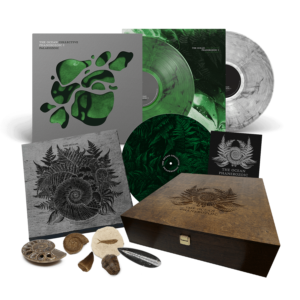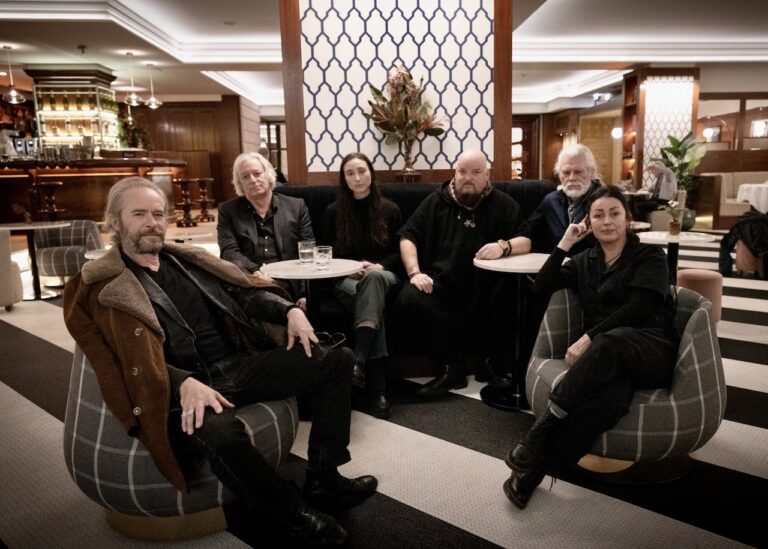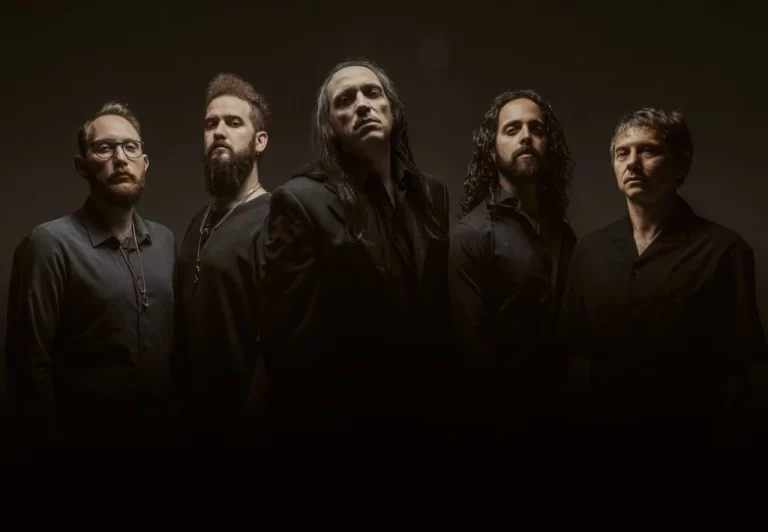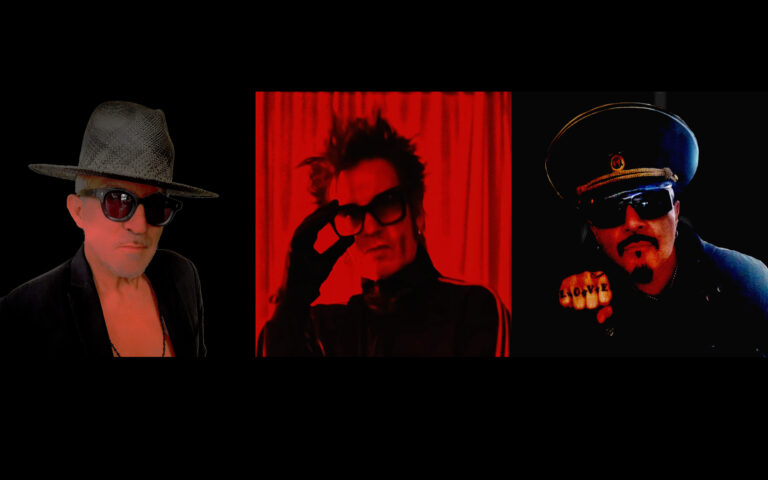Returning to the themes of Precambrian, The Ocean’s sprawling 2007 masterpiece, Phanerozoic is a three-part record (spread over two separate releases) that fills in the conceptual gap between Precambrian and its immediate follow-up, Heliocentric. With the first part, Paleozoic out now on the band’s own Pelagic records, we took the opportunity to speak to the band’s driving force, Robin Stapps. In a lengthy discussion that took in the band’s stunning artwork, the development of the concept and the stunning Devonian: nascent, which features a typically ethereal turn from Katatonia’s Jonas Renkse, Robin took us through the formation of the latest release (and one of the albums of 2018) from The Ocean Collective.
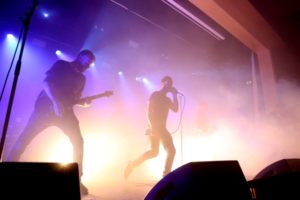
The first question is to do with the conceptualisation of the album and the way that this album forms a sequel to Precambrian – what made you decide to return to those themes having dealt with more anthropological issues, particularly on Heliocentric?
Well, it kind of… the initial idea for that came from two directions. One was that we had the tenth anniversary of Precambrian, this year or last year, and we decided to play this anniversary tour because we felt that it was a record that we felt, somehow, still felt fresh and relevant and we wanted to bring it out and do its entirety, which we never did at the time when it was released, so it was a challenge to do that. Then, while I was listening to the pre-productions of the new material, it felt like it connected very well with the Cambrian vibe form back in the day and, without the vocals and without Louic singing over the tracks it felt like, yeah, there was a similar vibe going on, so it made sense to go back and continue where Precambrian left off. Also because there was this gap both conceptually and musically between Precambrian and then heliocentric and we wanted to fill that void somehow with a record that bridges the Precambrian era with the Centrics, which were released in 2010. This material was shaping up to be the right stuff, somehow, musically and yeah, that’s how we ended up here. Basically when I was listening to the songs and that’s how I do it a lot, listening to the frame of the record. I listen a lot and try to close my eyes and try to visualise it somehow and these archaic Precambrian images came back immediately and I was like, “oh! Wait!” I’ve felt stuff like this before and it made sense to go back and continue.
I really like the idea of concept records and if you can get a concept that works in that way visually and thematically. When you think about writing the music are you thinking about the ebb and flow of the record as a whole and sequencing the piece, or does that come later?
Um, well in this case, to be honest, this record is more a loose collection of songs as compared to Pelagial, which was written in one go from the beginning to the end and it had to be done in that way because it was this journey form the surface to the bottom of the sea and the aim was to make it progressively lower in tuning and slower as we were progressing towards the depths, so in order to make that happen, we had to write it in a very linear way. The new material was initially isolated tracks which were then put together and arranged, of course, in the great scheme of things of the record. But yeah, it was an in intentional choice to do it that way because, as much as I really liked the challenge that Pelagial posed, I wanted to do something different now and after playing 300 shows with Pelagial where we had to do the same songs in the same order because that’s how they were written, and it’s also how we performed it live, we got a little bit tired of this over… of too much concept. We wanted to be free to move songs around and combine new songs with older songs as well, so we decided to keep this a bit looser and yeah, so, those songs… they still have a lot of coherence to them, I think. They have this continuous vibe that goes from the beginning of the first track through to the last song and that’s because they were all written at the same time and they have that coherence, but at the same time they weren’t written in a linear progression. They were written as isolated tracks and then put together.
As I understand it, this record follows in the footsteps of Precambrian in that Precambrian was divided into two separate movements where there was the mini CD (which was so cool, by the way) and then the more orchestral tracks on the second disc, albeit this album is spread over two separate albums
That’s right, there’s going to be a second part of Phanerozoic, which will be released in 2020 probably. It’s actually already been written. We’ve tracked guitars and drums for it already, so the song material already exists, but we decided to focus on the first part first, then tour on the first part and then continue working on the second part and I think that was a good choice because people’s attention span is short these days and also I tend to put too much weight on my shoulders – more than I can usually handle – and I’ve learned from that and I want to focus on one thing first. But, yes, there is a second album, that’s right. Actually, the Phanerozoic album is divided in to three parts, actually, which corresponds to the geological eras. The Phanerozoic is divided into three eras – there’s the Palaeozoic, which is the title of this record. Then the Mesozoic, and Xenozoic and the second part is going to comprise these second and third parts – the Mesozoic and Xenozoic eras. So it’s going to be two vinyls – one for each era and six songs for the Palaeozoic (which is this record) and three songs each for the Mesozoic and Xenozoic eras. So, a total of six songs per album as well. We decided to release Mesozoic and Xenozoic together because, well, it was making sense with the amount of songs and the amount of musical material as well. We could also have released it as two separate EPs but EPs are not as cool as albums, so we decided to put these two parts together and release it as one record.
For me, one of the strongest songs on the new record is the piece with Jonas Renkse from Katatonia and I believe you did, at one point, an interview in which you said that Katatonia were the band that changed your perception of clean vocals in heavy metal.
Yeah, that’s right, yeah. I wasn’t’ really much into heavy bands with clean vocals for a long time because usually that wouldn’t mean the type of clean vocals that I was in to. Lots of falsetto and tremolo and that kind of stuff, and Jonas kind of proved that heavy music with this very clean voice was actually working very well. The low tuned guitars on the Great Cold Distance and then this perfectly clean and very melancholic singing over it. That really did something to me that had not been done before somehow. I really got into that when it was released and it was about the same time that we released Precambrian, actually, and we were already talking to Jonas at that time and approached him about a guest appearance and, he was into it, but we couldn’t make it work timing wise because we were already mixing our record and they were in the studio recording The Great Cold Distance, so it didn’t happen and now, ten years later, ironically we ended up playing a gig with them in Romania last year when they played the album in its entirety and they invited us and then the whole thing came back and were like “wait, we already had this idea ten years ago!” So, we hit up Jonas and he was so into the idea of doing something together, so I sent him this track that I felt could work very well with his voice. It wasn’t specifically written for him, but when I was listening to the whole record, I was like “that’s the one!” I could really imagine that, and he could too, so, yeah, he got back to us with some demos which were 98% of what ended up on the record. The first thing we heard from him was just so perfect that we all thought “OK – this really makes sense!” It does sound like Katatonia, obviously – because this is the voice of Katatonia. But it also sounds like The Ocean, and he’s really made his… really made our song his own, somehow, by taking the song into his realm and adding his voice to it and making it work. There was a really cool experience and it was how we imagined a guest appearance or collaboration would work. We didn’t have to explain to someone what to do – I really didn’t do that. He wrote his own lyrics. I didn’t tell him to sing over a certain part – I didn’t give him any instructions, just “here’s the track, do with it whatever you want” and he did and it was awesome.
I had read that he wrote his own lyrics and I was surprised about that because of the conceptual theme…
Of course, I did give him insight on that. I sent him some of the lyrics I had written already, I told him about the whole album concept and how it ties to Precambrian, so he was aware of that. But I really did want him to write his own lyrics, because I think with any kind of vocal delivery, it has to be somehow personalised. With Louic and me, although I often write the lyrics, we still talk about it and we work on the vocal parts together in the studio, me and him, and I didn’t have the chance to do that with Jonas. I really wanted him to deliver something he could affiliate himself with and to make that possible, I gave him the specs of the record and told him to do what he wanted, and I think it worked out great.
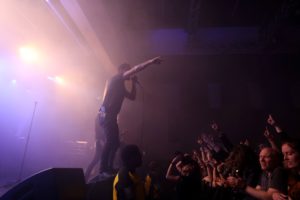
I remember when I first got the Precambrian album, and I think I got it on CD first and then vinyl later, but one of the things that attracted me to it is that I’m a terrible music geek and the amount of attention to detail and care that went into that package – I think it’s still one of the nicest CDs in my collection. Then, very soon after that, you came out with Heliocentric, which came in that amazing vinyl box set… so obviously producing a piece of physical art to go with the music is very important to you…
It is indeed. Yes. I believe that, first of all, for the record label perspective – I release these records through my own label, Pelagic, so that’s important. I think it’s very important to give people a reason to still buy music as a physical product and I think the best reason you could give them is outstanding packaging because that’s something you can’t copy or download or clone in a digital way. So, it makes sense form that angle and, as an artist and musician, I’ve always tried to look at what we do with the Ocean as a… basically from all different directions of art. And, it’s not just the music, which is obviously the most important thing, but the record packaging, The actual artwork, the lyrics, the live presentation, the lighting live, the video projections – all of this is part of the whole and that’s why we’ve always taken care of that. And, I also… I was always interested in this haptic way of developing record artworks and packaging. It’s a total different challenge, obviously, to the musical aspect and I’ve always been very much intrigued by what is possible in pushing the boundaries – for example with regards materials and printing techniques and… for the Centrics we had these dials attached to the gatefold, and all of this was very experimental. We had to do a lot of tests and it’s the same thing now for Phanerozoic – the reason why the vinyl is terribly delayed is that the pressing plant prematurely said “oh yeah, we’ll do it!” and then, when it went into production, they came back and said “it actually doesn’t work, it’s physically not possible to do what we wanted to do.” So, we had to improvise again and we had to make the same gambles and try different things and yeah, it’s a risky thing because it can lead to delays and sheer failure sometimes when you realise something’s just not working out. The foil doesn’t stick to the plastics – we had that problem with the Centrics for example – but it’s also greatly interesting and when you hold that thing in your hand in the end, it’s something spectacular and outstanding and no one’s done anything like that before and that’s very much rewarding and I’ve always been interested in working with that side of music as well.
It’s fantastic – I think anytime anyone visits I bring out the Centrics box set and it’s like “hey! Look at this, it’s so cool!” So, slightly tangentially, but that’s one of the reasons I was really pleased when Pelagic picked up Arabrot because the potential for artistic collaboration there is so cool and interesting.
Well, yeah, we’ve already been out with those guys. The Damnation fest was part of that tour where Arabrot were opening the night and I think it was a very interesting package to look forward to and hopefully we’ll do more with Kjetil – he’s a very interesting character and a great guy to have around and really forward thinking with his own music and live performance. Having those guys on board for the tour was a really cool option to have on that tour and they also interest a lot of different people who maybe wouldn’t be that interested in the Ocean and, at the same time, our fans were… they got a lot of very good feedback on the tour from people who wouldn’t normally come out to see Arabrot and that’s what you want from a good package. There should be certain overlaps, but also, each band should bring in their own crowd and offer a different approach to music because no one wants to see the same band three or four times per night. It’s good to have some tension there and yeah, it’s different, but still similar enough to work for the crowd that comes out to the gig and I think, from all those angles, they were really cool to have on board, and yeah, I’m looking forward to do more with those guys. They have so much output too – there are already the next couple of releases pencilled out. They’re almost ready to go and, sometimes I have to slow Kjetil down and get him to focus on one thing first. He already had the next couple of releases in his mind and that’s just symptoms of a great artist with a lot of output. It’s very cool.
Last time you played at Damnation, I think, you’d just done Transcendental, the split release with Mono and I wondered if you had any plans to do anything similar to that, because that was a really interesting and really cool pairing.
Yeah, I think so too! Well, we specifically did that for the tour we did together in 2015 and also, I’ve been a huge fan of Mono since 2003. Actually, the Ocean had supported Mono back in 2003 in Berlin once and I’ve known the band for a long time. I was very happy to make that collaboration happen. That was part of what we call the Pelagic split series, we released a couple of other editions and other pairings. There was a split with EF and Tiny fingers, there was one with Cult of Luna and my other band, the old wind, so it’s part of an ongoing series, but actually we haven’t done a new edition this year, yet. There have been a lot of other projects, but I plan to continue that and release more splits with Pelagic artists and maybe something with The Ocean and a band that fits, but nothing definite is planned yet.
This is going back years, but I think you did an interview for Metal Hammer, possibly about the time of Precambrian, and at the time you were recording in an old U Boat factory or something like that?
Yeah! Our first ever rehearsal space and I hesitate to use that term because it was a place where we lived at times, where we rehearsed and where we recorded our first three records. It was a huge underground space in the old Berlin and it was an aluminium factory, actually, and it made doors for submarines and when we came down there, there was still one of those doors standing there because no one had been in that basement for thirty or forty years, before we actually rented it for very little money in 2001 or 2000 and made it accessible. So, yes, they made aluminium doors for submarines there and one of those doors was still down there, but it was actually an aluminium factory and after the end of the war they made kitchen parts and they actually went out of business in the early fifties, I think. So, no one had been down there, so we found this place and convinced the landlord to rent it to us for a ridiculously low rate and that’s where the Ocean was initially started and that’s where we could rehearse and the percussionist who was with us at that time was drumming on oil barrels and all these things that took up a lot of space, so that space made the band and the collective possible in the early days, Without that space, we may never have come to be a band.
I love the image, it sounds like a very evocative environment and it’s perfect for a band named the Ocean Collective to be working in something like that!
Yeah, of course!
So, just to cap off the interview, obviously you have the recording to do for the next part of Phanerozoic, so what are your plans going into 2019?
Well, we’ve just got back from the first part of our tour. There’s going to be a second leg that is going to happen in March /early April where we’ll hit all the territories we skipped on this part of the tour. There’ll probably also be more UK dates because we just did London and Leeds on this tour, so, yeah – that’s happening in March/April. We are going to India in early January for five club shows, then to Australia to headline a prog fest in late January. Then to New Zealand in early February, so we’ll be gone pretty much from New Year to early February. Then we’ll be home for three or four weeks in Europe, then we’ll be out again. So, those are the immediate plans. Then there are the summer festivals next year – we just announced Hellfest, we’re doing resurrection fest and a bunch of other festivals and, at one point next year we want to return to the US as well, so this is currently being discussed. So, we’re actually touring a lot and it’s going to be quite difficult to squeeze in the writing and recording sessions we still need to do. We mainly need to write vocals – everything else is already recorded. But that is something that takes time and I think we’re looking at doing that in April / May after that second European tour – Louic and me will retreat back to our secret little place by the sea where we always record and then we’ll mix the record in the summer or the early fall. That’s the plan for now.
